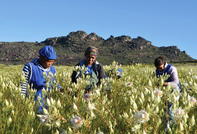Proteas, recognised world-wide as flowers ‘indigenous’ to South Africa, actually grow wild in many countries, in fact, on all of the southern continents of the world. Proteaceae evolved on nutrient-poor soils and can grow as small trees, shrubs and prostrate ground cover.

When selecting a site for protea production, good soil drainage is the most important requirement. Relatively low concentrations of nutrients are required for protea production, however, most species react favourably to nitrogen. Most proteas are intolerant to high levels of phosphorus, even in amounts that would be ‘moderate’ for non-Proteaceae plants. Proteas scavenge phosphorus from soils with low phosphorus levels.
For the best quality and shelf-life, proteas should be harvested at the ’soft-tip’ stage. This is when the flower bracts begin to loosen but still cohere. Flowers that were picked too early will not open. A serious problem with several species of protea is the discolouration of leaves soon after harvesting. Refrigeration during postharvest storage, packaging, and shipping, delays the onset of leaf blackening.
World Production of Proteas
The production of cut-flowers is calculated in the number of stems. The Proteaceae family are often the most recognisable fynbos, with their huge distinctive flowers, but the family comprises about 1 400 species, of which only 400 species are indigenous to Africa. Over 800 species in 45 genera are from Australia. Proteas are also naturally found in Central and South America, on islands near New Guinea, in Madagascar, New Zealand and Southeast Asia.
South Africa has the largest area under cultivation - around 1 200 ha (2019) and permits have been issued for wild-harvesting in about 1 000 000 ha. Of this, only about 10% is accessible as most of it includes mountainous areas in the Western Cape.
The commercial growing of traditional South Africa indigenous plants is not confined to South Africa's Western Cape Province. Cape flora is also planted in Portugal, California in the USA, Israel and the Canary Islands. In 2000 it was estimated that around 6 000 hectares were under protea cultivation worldwide.
Some production is also done in Central and South America, Japan, Australia and China. Costa Rica, Ecuador and Chile are major competitor countries from the southern hemisphere, while protea supplies from Australia to Japan is declining due to labour costs.
An example of the South African cut-flower industry’s international aspects is the Leucadendron cultivar ‘Safari Sunset’. The original plant material came from South Africa, it was hybridised in New Zealand and today Israel sells millions of stems each year.
Protea Production Areas in South Africa
According to Dr Gerhard Malan, consultant and technical advisor, South Africa has about 1 200 ha under indigenous cut-flower cultivation with about 715 ha under proteas, 183 ha dedicated to Leucospermums and 147 ha planted with Leucadendron. The planting of Leucadendron and greens are increasing by about 11% (2016 compared to 2017).
Wild harvesting and cultivation of indigenous flora is concentrated in the Overberg, Piketberg (including Porterville) and Boland, with smaller areas of production extending from the southern Cederberg and eastwards along the mountain belts and coastal plains of the Southern Cape.
Some indigenous fynbos plant species, suitable for cut-flower production, are used by farmers to diversify their farming operations. Fynbos is suitable for production, in areas with nutrient-poor soils and limited water, where intensive fruit, grain or livestock production will not thrive. For example, fynbos demand 35-45 % less water than other horticultural crops, such as apples.
By Marinda Louw
For bulk or Cut-flower export enquiries please use the enquiry link below.